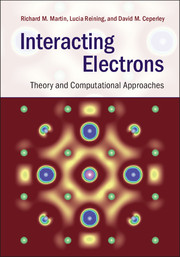Book contents
- Frontmatter
- Dedication
- Contents
- Preface
- Acknowledgments
- Notation
- Part I Interacting electrons: beyond the independent-particle picture
- Part II Foundations of theory for many-body systems
- Part III Many-body Green's function methods
- Part IV Stochastic methods
- Part V Appendices
- Appendix A Second quantization
- Appendix B Pictures
- Appendix C Green's functions: general properties
- Appendix D Matsubara formulation for Green's functions for T ≠ 0
- Appendix E Time ordering, contours, and non-equilibrium
- Appendix F Hedin's equations in a basis
- Appendix G Unique solutions in Green's function theory
- Appendix H Properties of functionals
- Appendix I Auxiliary systems and constrained search
- Appendix J Derivation of the Luttinger theorem
- Appendix K Gutzwiller and Hubbard approaches
- References
- Index
Appendix I - Auxiliary systems and constrained search
from Part V - Appendices
Published online by Cambridge University Press: 05 June 2016
- Frontmatter
- Dedication
- Contents
- Preface
- Acknowledgments
- Notation
- Part I Interacting electrons: beyond the independent-particle picture
- Part II Foundations of theory for many-body systems
- Part III Many-body Green's function methods
- Part IV Stochastic methods
- Part V Appendices
- Appendix A Second quantization
- Appendix B Pictures
- Appendix C Green's functions: general properties
- Appendix D Matsubara formulation for Green's functions for T ≠ 0
- Appendix E Time ordering, contours, and non-equilibrium
- Appendix F Hedin's equations in a basis
- Appendix G Unique solutions in Green's function theory
- Appendix H Properties of functionals
- Appendix I Auxiliary systems and constrained search
- Appendix J Derivation of the Luttinger theorem
- Appendix K Gutzwiller and Hubbard approaches
- References
- Index
Summary
Summary
Here we consider auxiliary systems that are generalizations of the Kohn–Sham construction. In Green's function methods the use of a self-energy from an auxiliary system can be considered as a search in a restricted domain. Dynamical mean-field theory is an example of an interacting auxiliary system.
There are various ways that functionals can be employed to generate auxiliary systems and useful approximations by limiting the range of the functions input to the functional. Each of the functionals of the density, Green's function, or self-energy are defined over a specified domain D, e.g., ФG] and F[∑] are defined for all functions that have the required analytic properties for a Green's function or self-energy (see Sec. H.1). Here we consider limiting the domain to a subset of D denoted by D′. The first examples below derive expressions that provide insights concerning the link of non-locality and frequency dependence, and that lead to useful approximations in the spirit of optimized effective potentials. This is followed by an approach to find an interacting auxiliary system where the full many-body problem can be solved with no approximations, thus providing a self-energy that is exact within the restricted domain of the auxiliary system.
Auxiliary system to reproduce selected quantities
Let us first consider an auxiliary system that reproduces exactly some quantity of interest. This is similar to the Kohn–Sham approach, but it is more general and it leads to explicit expressions for the functionals in terms of Green's functions [1163].
Suppose we are interested in a quantity P that is part of the information carried by the Green's function G, symbolically expressed as P = p{G}. An example is the density where the “part” to be taken is the diagonal of the one-particle G: p{G} = n(r) = −iG(r, r, t′−t = 0+) or −G(r, r, τ = 0−). Consider an auxiliary system that has the same bare Green's function G0 as the original one, but a different effective potential, or a self-energy ∑P that leads to an auxiliary Green's function GP.
- Type
- Chapter
- Information
- Interacting ElectronsTheory and Computational Approaches, pp. 731 - 734Publisher: Cambridge University PressPrint publication year: 2016



